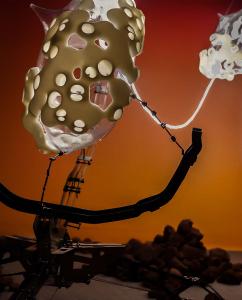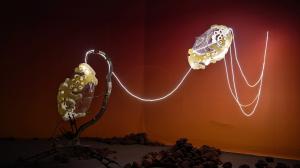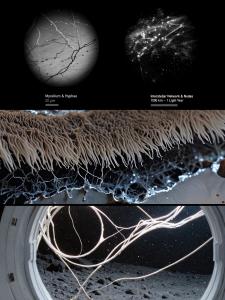Black Void's Astromycology: Terraforming Mars through Mycelium
Through digital generation and speculative archaeology, Biosphere 3 challenges our ethical framework regarding extraterrestrial life and interstellar migration.
BIOSPHERE 3
In astromycology initiatives spearheaded by leading aerospace research institutions, fungi have been genetically engineered to serve as builders, conductors, network engineers, and chemists on Mars, breaking down its hardened crust to lay the groundwork for terrestrial life. However, the work’s narrative challenges this assumption: Martian fungi assimilate the first astronauts and sever contact with Earth. Just before the disconnection, the protagonist questions: "Are we seeking to conquer space, or are we endlessly replicating Earth? Do we aim to discover new forms of cosmic life, or are we merely searching for a mirror?"
The work seeks to reveal a fundamental contradiction between fungi’s decentralized networks and interstellar migration: we are often fascinated by the decentralized intelligence systems of fungi, hoping they will lead us to discover new worlds, but have we established a sufficient ethical framework to embrace unknown non-Earth life? From the perspective of particles and energy flow, humanity has never truly “conquered” Mars; rather, we have always been a part of it. What we need is not only technological preparation but a fundamental shift in ethics and philosophy — how to integrate into a boundless community of life?
"Biosphere 3" includes a digital life generation system, three installations, and a short film. Through a parametric generation system, the artist created Martian fungi in a digital environment, using code to enable reproduction, symbolizing uncertainty and randomness. These fungi are brought into physical form through 3D printing, creating bizarre, newborn life forms in the red-orange exhibition hall. Accompanying the installations, the film blends digital models, AI-generated technology, and real Mars rover footage, telling the story of the first astronauts discovering Martian fungi.
ASTROMYCOLOGY
Fungi were the first organisms to arrive on land on Earth. After the atomic bombing of Hiroshima in 1945, matsutake mushrooms were among the first to grow. Similarly, after the Chernobyl nuclear disaster, scientists found black fungi thriving inside the reactor, using radiation as energy to create nutrients.
NASA has supported Astromycology research, led by Paul Stamets and others, which explores fungi’s potential to support life in space. Fungi could decompose Mars' regolith, break down harmful substances, and convert waste from space travel into vitamins and minerals, creating a sustainable soil substrate. Fungi could also provide food, building materials, and even energy through biomass.
DIGITAL LIFE
In a digital environment, the artist generated fungal forms linked to Martian environmental parameters like temperature, air pressure, and radiation. The shapes of the fungi evolved in response to these factors, reflecting the environmental changes on Mars. This model of digital life generation offers a new possibility for life: reproduction through code, decentralized, networked individuals filled with uncertainty and the potential for mutation.
Throughout the creative process, the fungi’s ever-changing forms merged with the artist’s imagination of silicon-carbon-based life. The film portrays how Mars’ ultra-low temperatures could allow electromagnetic phenomena to accumulate, leading to intelligence. The mycelium communicates with electrical signals, developing a form of “vocabulary.” Additionally, space radiation provides new nourishment, and the fungi adapt by adjusting their pigments to absorb various types of radiation.
These digital life forms are also realized in 3D printing, transitioning from virtual to physical, in a Martian landscape filled with red-orange hues, resembling bizarre life forms, with faint electrical sounds, sitting atop a doomsday-like terrain.
FUTURE ARCHAEOLOGY
The film’s perspective shifts to decades after humans first land on Mars, where astronauts discover Martian fungi growing in valleys, craters, and glaciers. Initially, the astronauts are thrilled by the discovery, but they soon realize the fungi possess strange abilities: they can perceive the astronauts' emotions, communicate via chemical signals and light pulses, and share sensory experiences. The fungi extend their consciousness across the Martian landscape, gradually eroding the outer layers of the spacecraft and astronauts' suits, forcing them into direct biological connection with the fungi.
Eventually, the astronauts sever communication with Earth, declaring: “Mars is not a mirror of Earth; it will never reflect Earth. I am here now, and there is no need to return—wherever I am, I am with you through my existence.” The fungal colony, like the ocean in Tarkovsky’s Solaris, is a wordless presence — a profound mirror of the soul. It reflects deep desires and the longing for the unknown, existing without clear boundaries and spreading across every inch of Mars.
This colony is no longer an external life form but, through its connection with the astronauts' consciousness, transforms into a symbiotic entity that tightly connects human consciousness with Mars’ land, air, and even distant stars. Interaction with the fungi is no longer one-sided; it evolves into a shared existence, suggesting that humans can no longer place it in a closed, isolated framework. The work proposes an inevitable new reality: humanity’s connection with life on Mars and beyond cannot be grasped through conquest or isolation, but only through integration and symbiosis.
CAI Yixuan
Black Void
+86 152 0108 2606
email us here
Visit us on social media:
Instagram
X
Legal Disclaimer:
EIN Presswire provides this news content "as is" without warranty of any kind. We do not accept any responsibility or liability for the accuracy, content, images, videos, licenses, completeness, legality, or reliability of the information contained in this article. If you have any complaints or copyright issues related to this article, kindly contact the author above.
Transforming the Beauty Industry: Mini Packaging for Cosmetics and Personal Care Poised to Thrive with Robust Growth
Moongate Films Launches to Bring East Asian Stories to Global Screens
Modular Kitchen Baskets Market to Reach USD 1.8 Billion by 2035, Driven by Customization and Efficient Storage Demand.
Więcej ważnych informacji
 Jedynka Newserii
Jedynka Newserii

 Jedynka Newserii
Jedynka Newserii

Ochrona środowiska

A. Bryłka (Konfederacja): Ograniczenie emisyjności nie musi się odbywać za pomocą celów klimatycznych. Są absurdalne, nierealne i niszczące europejską gospodarkę
W lipcu br. Komisja Europejska ogłosiła propozycję nowego celu klimatycznego, który zakłada ograniczenie emisji gazów cieplarnianych o 90 proc. do 2040 roku w porównaniu do stanu z 1990 roku. Został on zaproponowany bez zgody państw członkowskich, w przeciwieństwie do poprzednich celów na 2030 i 2050 rok. Polscy europarlamentarzyści uważają ochronę środowiska i zmiany w jej zakresie za potrzebne, jednak nie powinny się odbywać za pomocą nieosiągalnych celów klimatycznych.
Polityka
Dramatyczna sytuacja ludności w Strefie Gazy. Pilnie potrzebna dobrze zorganizowana pomoc humanitarna

Według danych organizacji Nutrition Cluster w Strefie Gazy w lipcu br. u prawie 12 tys. dzieci poniżej piątego roku życia stwierdzono ostre niedożywienie. To najwyższa miesięczna liczba odnotowana do tej pory. Mimo zniesienia całkowitej blokady Strefy Gazy sytuacja w dalszym ciągu jest dramatyczna, a z każdym dniem się pogarsza. Przedstawiciele Polskiej Akcji Humanitarnej uważają, że potrzebna jest natychmiastowa pomoc, która musi być dostosowana do aktualnych potrzeb poszkodowanych i wsparta przez stronę izraelską.
Polityka
Wśród Polaków rośnie zainteresowanie produktami emerytalnymi. Coraz chętniej wpłacają oszczędności na konta IKE i IKZE

Wzrosła liczba osób, które oszczędzają na cele emerytalne, jak również wartość zgromadzonych środków. Liczba uczestników systemu emerytalnego wyniosła w 2024 roku ponad 20,8 mln osób, a wartość aktywów – 307,5 mld zł – wynika z najnowszych danych Urzędu Komisji Nadzoru Finansowego (UKNF). Wyraźny wzrost odnotowano w przypadku rachunków IKE i IKZE, na których korzyść działają m.in. zachęty podatkowe. Wpłacane na nie oszczędności są inwestowane, a tym samym wspierają gospodarkę i mogą przynosić atrakcyjną stopę zwrotu.
Partner serwisu
Szkolenia

Akademia Newserii
Akademia Newserii to projekt, w ramach którego najlepsi polscy dziennikarze biznesowi, giełdowi oraz lifestylowi, a także szkoleniowcy z wieloletnim doświadczeniem dzielą się swoją wiedzą nt. pracy z mediami.










.gif)

 |
| |
| |
|